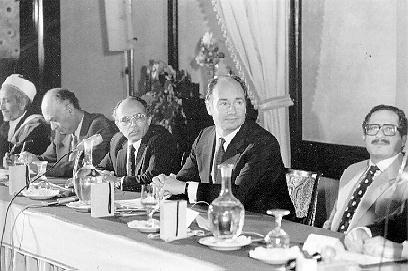Aga Khan Award for Architecture 1983 - 1983-05-26
Mowlana Hazar Imam and President Evren of Turkey on September 4, 1983 presented the 1983 Aga Khan Award for Architecture to 11 outstanding projects located in nine countries from Yugoslavia to Malaysia (See the photographs and project descriptions in the present issue of AFRICA ISMAILI). The winners share US $500,000 of prizes from the fund established by the largest architecture award programme in the world.
President Evren, speaking to over 400 international and Turkish government officials, diplomats, architects and scholars gathered at the Topkapi Palace in Istanbul called for greater appreciation by the Islamic world of its own deeply rooted culture. He commended the Aga Khan Award for Architecture for promotion the preservation of Islamic heritage through architecture in the face of ever-changing economic and social conditions.
In his speech, Mowlana Hazar Imam, the Award's founder and chairman, spoke of the conflict between technology and traditional cultures as an important issue in the Islamic world today. He stressed, however, that the Islamic world is not alone in facing this conflict. 'Nations as far apart as Japan and Spain, as the Philippines and France are attempting to reconcile the conflicting demands of maintaining their own cultural identities and yet achieving technological progress'.
Hazar Imam emphasised that from its inception, the Award has been concerned with this important issue. 'We have hoped to inspire a new sense of direction,' he said, 'and stimulate fresh thinking and creativity while appreciating the value of historical tradition and what can be learned from the past.'
The 1983 winners reflect the scope of the Award's concerns as well as the very diversity of the Islamic world. The winners range from a traditional mud mosque in Niono, Mali, to the contemporary Hajj Air Terminal in Jeddah, Saudi Arabia, honouring on the one hand the traditional craftsmanship of a master mason while on the other hand the imaginative and innovative use of 20th century building technology.
The Award was established in 1976 by Mowlana Hazar Imam to heighten awareness of Islamic culture. It seeks to recognize those projects which meet today's needs while being in harmony with the heritage of its users and which will enrich the future physical environment of the Muslim world. However, because of its scope, the Aga Khan Award for Architecture deals with issue which are not unique to the Muslim world nor confined to developing countries. In addition to the triennial prize, the Award organises a number of programmes, including international seminars, research activities and special publications. The first awards were presented in 1980 in Lahore, Pakistan to 15 projects in the Muslim world from Senegal to Indonesia.
The 1983 nine-member Master Jury, consisting of individuals from various disciplines in addition to architects from both the Muslim and the western world, examined a total of 216 projects from more than 50 countries. They identified those individuals most responsible for the winning projects' merits and cited among the Award's recipients architects, design and construction professionals, craftsmen, institutions, communities and clients.
In addition to the Niono mosque and the Hajj Terminal, 1983 winners include Sherefudin's white mosque in Visoko, Yugoslavia, recognised as a design skillfully combining traditional and modern architectural elements and for its potential contribution to a changing architectural heritage.
Two very different housing projects were also premiated. A housing scheme reconstructed from the debris of a destroyed slum quarter in the Medina of Tunis, in Tunisia, received an award for its attempt to deal with the problem of urban public housing in a humane fashion. The Nail Cakirhan residence, a private house in the village of Akyaka in Turkey was cited for its use of space and its sensitive revival of traditional crafts in the area.
Two tourism projects also feature among the recipients of this year's award. The Tanjong Jara Beach Hotel/Rantau Abang Visitors' Centre in Kuala Trengganu, Malaysia was recognised for successfully adapting and developing a rapidly disappearing traditional architecture and crafts. In Sousse, Tunisia, the Residence Andalous, an apartment hotel, was chosen for its contemporary expression of traditional Tunisian architecture and design.
The Ramses Wissa Wassef Arts Centre in Giza, Egypt, was cited not only for its architectural excellence but also as an institution emerging from a successful experiment to preserve and develop the role of traditional crafts in contemporary life.
In keeping with the Award's concern for the preservation of Islamic heritage, the Master Jury recognised three outstanding restoration projects - the 14th century Tuglug period tomb of Shah Rukn-I-Alam in Multan, Pakistan, the ancient Darb Qirmiz Quarter in Egypt and the 18th century Azem Palace, a masterpiece of Islamic architecture, in Damascus, Syria.
The Master Jury in their official statement declared that the winning projects were recognised for their architectural merit while responding to social, economic, technical, physical and environmental challenges. The Jury echoed the 1980 Master Jury statement that the winning projects reflect the present stage of transition, experimentation and continued search in Muslim societies.
'In most instances, they represent not the ultimate in architectural excellence, but steps in a process of discovery.'
Hazar Imam in his concluding remarks at the presentation ceremony emphasised this very theme: 'If the Award is to respond adequately to the challenges facing us, it must always look to the future. The search for solutions is a voyage of discovery on which we must neither fail to gain from experience nor fear to explore further.
(Source: Af. Ismaili Dec 1983)
- 3894 reads
 Ismaili.NET - Heritage F.I.E.L.D.
Ismaili.NET - Heritage F.I.E.L.D.